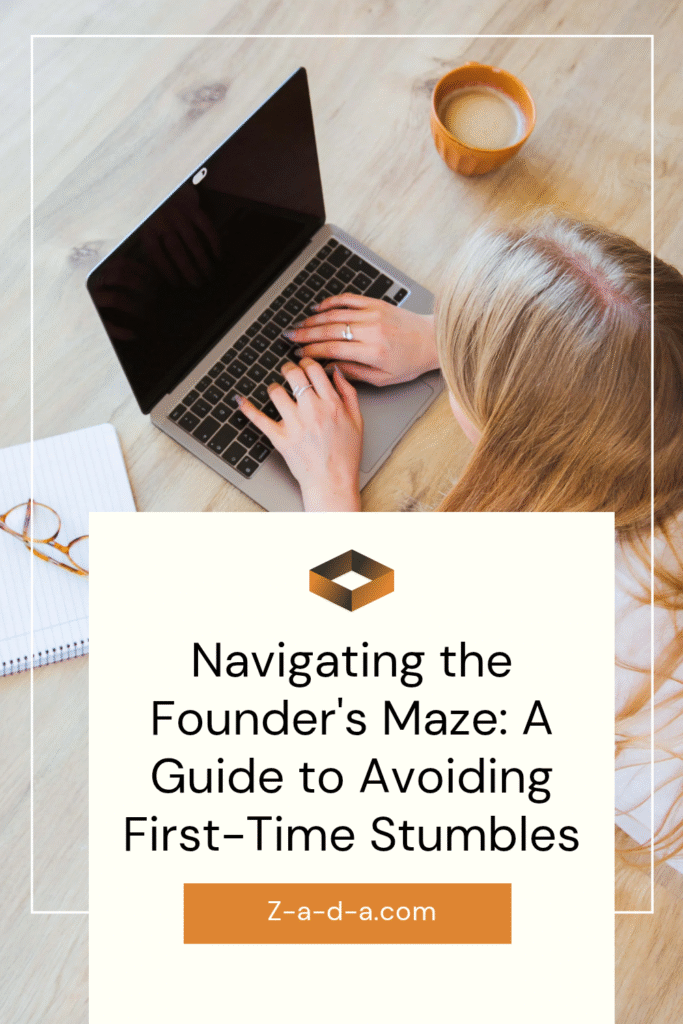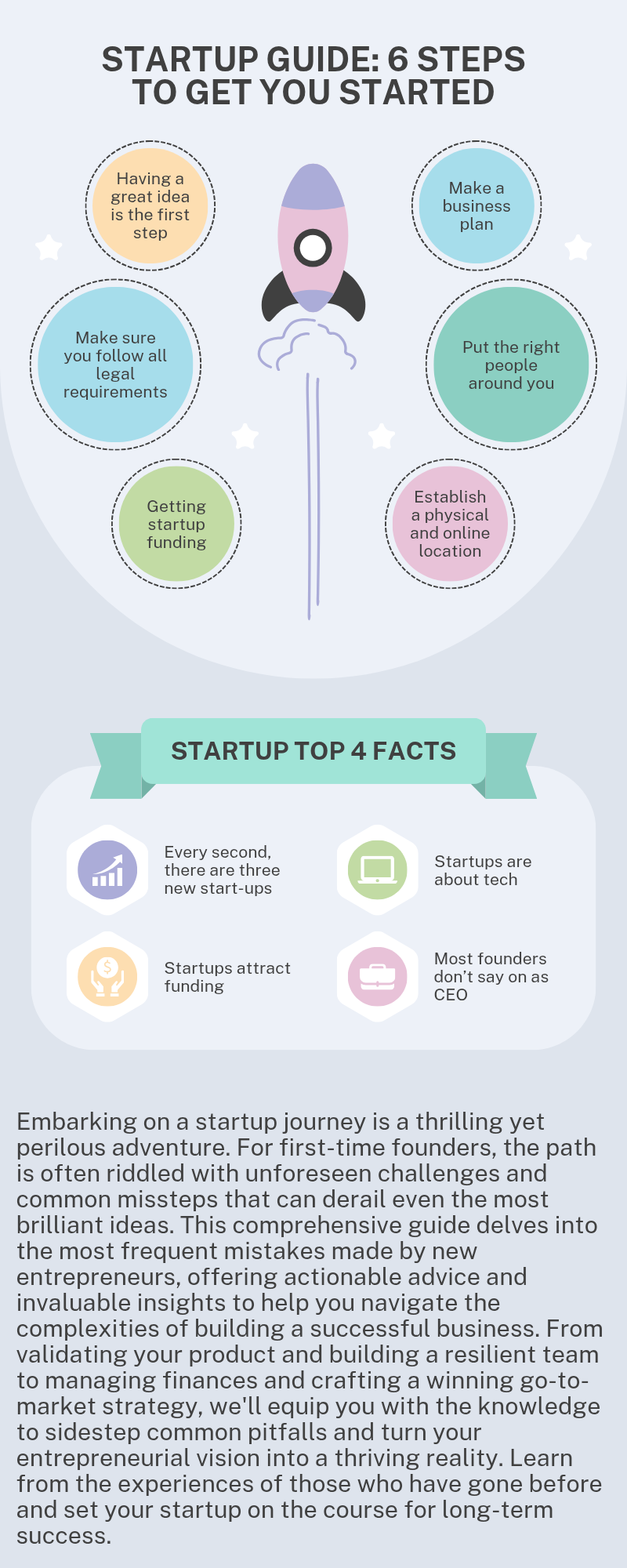
The entrepreneurial journey is a siren’s call to the ambitious and the innovative.
It promises the thrill of creation, the satisfaction of solving real-world problems, and the potential for immense reward.
Yet, for every celebrated success story, there are countless tales of startups that faltered, not for lack of a brilliant idea, but due to a series of avoidable missteps.
First-time founders, in their passion and drive, are particularly susceptible to these common pitfalls.
The statistics can be daunting, with some studies suggesting that as many as 90% of startups fail.
However, this isn’t a reason for despair, but rather a call for preparation.
By understanding the common mistakes that have tripped up so many before, you can navigate the founder’s maze with greater confidence and increase your odds of success.
This guide will illuminate the most frequent errors made by first-time founders, providing a roadmap to help you steer clear of these treacherous waters.
We’ll explore the critical areas where new entrepreneurs often go wrong, from the initial conception of an idea to the complexities of scaling a business.
The Foundation: Product, Market, and Plan
At the very core of any successful startup lies a solid foundation built on a product that people need, a clear understanding of the market, and a well-defined plan.
It’s in this fundamental stage that many first-time founders make their most critical errors.

Videos are added as random thoughts…💭💭💭
Mistake 1: Building Without Validating the Problem
Too many entrepreneurs fall in love with their solution before they’ve truly understood the problem.
They become so enamored with their “brilliant idea” that they neglect to ask the most crucial question:
“Is this something people actually need and are willing to pay for?”
This “if we build it, they will come” mentality is a dangerous trap.
The number one reason for startup failure is often cited as “no market need.”
How to Avoid It: Before writing a single line of code or manufacturing a prototype, get out of the building and talk to potential customers.
Conduct extensive market research to understand your target audience, their pain points, and their current solutions.
Simple tools like surveys, landing page tests with a waitlist, and customer discovery interviews can provide invaluable insights and validate whether you’re solving a real and urgent problem.
Mistake 2: Neglecting the Business Plan
The old adage, “failing to plan is planning to fail,” holds particularly true in the startup world.
Many new entrepreneurs, in their haste to launch, skip the crucial step of creating a solid business plan.
A business plan is not just a document for potential investors; it’s your roadmap, defining your goals, outlining your strategies, and forecasting your finances.
Without it, it’s easy to lose focus and make costly misjudgments.
How to Avoid It: Take the time to develop a comprehensive business plan.
It doesn’t need to be a hundred-page tome, but it should clearly articulate your vision, mission, target market, competitive landscape, marketing and sales strategy, and financial projections.
This living document will serve as a guide for your decisions and a benchmark to measure your progress.
Mistake 3: Ignoring the Competition
Some founders believe their idea is so unique that they have no competition.
This is rarely the case. Ignoring your competitors means you’re missing out on valuable learning opportunities and potentially underestimating the challenges ahead.
How to Avoid It: Conduct a thorough competitive analysis.
Identify who your direct and indirect competitors are, what they offer, their pricing, and their marketing strategies.
This will not only help you differentiate your product but also identify potential gaps in the market you can exploit.
The Human Element: Team and Self
A startup is more than just a product; it’s a team of individuals working towards a common goal.
The human element, both in terms of the team you build and your own well-being as a founder, is a critical determinant of success.
Mistake 4: Choosing the Wrong Co-Founder
Starting a business with the wrong person is one of the most difficult mistakes to rectify.
Often, first-time founders partner with friends without critically evaluating their complementary skills and shared vision.
A lack of clear roles, responsibilities, and a formal founder’s agreement can lead to conflict and ultimately, the demise of the company.
How to Avoid It: Choose a co-founder with complementary skills and a shared long-term vision.
Have open and honest conversations about equity, roles, responsibilities, and values from the very beginning.
Formalize your partnership with a founder’s agreement to avoid future disputes.
Mistake 5: Hiring Too Quickly and the Wrong People
In the rush to grow, many founders make the mistake of hiring too many people too soon, often before achieving product-market fit.
This can quickly drain your financial resources and create a chaotic environment.
Furthermore, compromising on the quality of your initial hires can have a lasting negative impact on your company culture.
How to Avoid It: Be deliberate and strategic in your hiring. In the early days, consider using freelance or offshore talent to save money.
When you do hire full-time employees, ensure they are not only skilled but also a strong cultural fit.
Your first few hires will set the tone for the entire organization.
Don’t be afraid to fire poor hires quickly but kindly to protect your team’s morale and performance.
Mistake 6: Trying to Do Everything Alone and Neglecting Self-Care
The “do-it-all” founder mentality is a common trap.
While dedication is admirable, trying to handle every aspect of the business yourself will inevitably lead to burnout.
Many founders also neglect their own well-being, sacrificing rest and personal time for the sake of the startup.
How to Avoid It: Learn to delegate and trust your team.
As the company grows, your role will shift from “doing” to “mentoring.”
Don’t be afraid to ask for help from mentors, advisors, and other founders.
Prioritize your health and well-being; a burnt-out founder is of no use to their company.
The Engine of Growth: Funding and Go-to-Market
A great product and a strong team are essential, but without a clear path to customers and the financial resources to get there, even the most promising startup will stall.
Mistake 7: Poor Financial Planning and Burning Through Cash
Mismanaging finances is a leading cause of startup failure.
First-time founders often underestimate their costs, overspend on non-essential items like fancy offices, and fail to manage their cash flow effectively.
Running out of money is a harsh reality for many startups.
How to Avoid It: Create a detailed budget and track your expenses meticulously.
Understand your burn rate (how quickly you’re spending money) and your runway (how long you can operate with your current cash).
Be frugal in the early days and prioritize spending on activities that directly contribute to growth.
Secure enough funding to give yourself a sufficient buffer.
Mistake 8: Ignoring the Importance of a Go-to-Market Strategy
A brilliant product will not sell itself.
Many founders are so focused on product development that they neglect to create a clear plan for how they will acquire customers.
This “build it and they will come” fallacy often leads to a product with no users.
How to Avoid It: Develop a comprehensive go-to-market (GTM) strategy early on.
This should include identifying your target customer, defining your messaging and pricing, and selecting the most effective marketing and sales channels.
Start marketing even before your product is fully built to generate early interest and gather feedback.
Mistake 9: Raising Capital at the Wrong Time or from the Wrong People
Fundraising is a critical but often misunderstood process.
Raising money too early, too late, or from the wrong investors can be detrimental to your startup’s long-term health.
First-time founders can also be naive about how long the fundraising process takes.
How to Avoid It: Be strategic about when and from whom you raise money. Choose investors who not only provide capital but also bring valuable expertise and align with your vision.
Start building relationships with potential investors long before you need their money.
The Mindset of a Founder
Beyond the tangible aspects of product, team, and funding, the founder’s mindset plays a pivotal role in navigating the inevitable ups and downs of the startup journey.
Mistake 10: Being Too Attached to the First Idea
Your initial idea is a hypothesis, not a sacred text.
Many founders hold on to their first idea for far too long, even in the face of evidence that it’s not working.
How to Avoid It: Be open to feedback and willing to pivot.
The key to success is to iterate quickly, learn from your failures, and adapt your strategy based on market feedback.
Mistake 11: Falling into the Negativity Trap
The startup journey is a rollercoaster of highs and lows.
It’s easy to become discouraged by setbacks and naysayers.
How to Avoid It: Cultivate a positive and optimistic mindset.
Focus on your mission and celebrate small wins. Surround yourself with a supportive network of mentors and fellow entrepreneurs.
Mistake 12: Not Thinking Big Enough
While it’s important to start small and focused, some founders limit their potential by not thinking big enough from the outset.
How to Avoid It: While you should start with a niche market, have a vision for how your startup can scale and capture a larger market over time.
The Journey Ahead
The path of a first-time founder is undoubtedly challenging, but it is also incredibly rewarding.
By being aware of these common mistakes and proactively taking steps to avoid them,
you can significantly increase your chances of building a resilient and successful company.
Remember that entrepreneurship is a marathon, not a sprint.
Learn from your mistakes, stay adaptable, and never lose sight of the problem you’re trying to solve.
The lessons learned from the failures of others can be your most valuable asset on the road to success.
